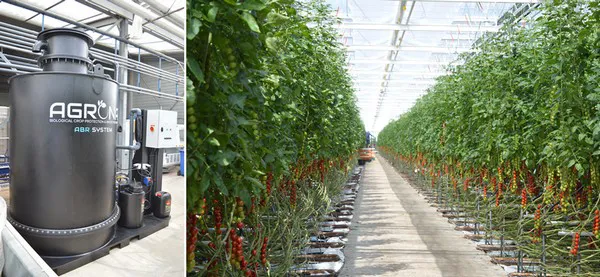This year, after a quick dip into the watering silo containing the daily supply at tomato grower Paul van Paassen, a diver confirmed: "No need to check this silo from now on Paul, because it is spotless."
The Bleiswijk grower with 2.2 hectares of glass has invested in his irrigation water quality in recent years and this is now paying off in good roots and healthy plants. Although, Paul already knew. "Air brings fruit, they used to say. Yet confirmation, even from a diver regarding his silo, is always welcome.

The latest investment Paul made was in an ABR Bioreactor.
100%
This year, the diver came across Agrona's now familiar OxyBull aeration system in Paul's daily storage silo. The grower invested in it in 2017. "Of course, as a grower you are always looking at how your roots are doing and at optimizing your irrigation water, but a few years back I really started to consciously put extra effort into this. Getting more oxygen into the water appealed to me and with the OxyBull made this possible."
What's more, measurements show that there is much more oxygen in Paul's irrigation water these days. Nadir Laaguili, director of Agrona: "Of course it varies per year and per period, but we have managed to achieve an oxygen gain of 30 to 70 percent. We now measure 100% oxygen in the irrigation water as standard."
Clean
For Paul, the OxyBull has therefore turned out to be 'a must have'. "Every time the day's supply silo is replenished, the aeration system is switched on at the same time. That way the water is always of high quality."
What helps with this is that immediately after installing the OxyBull, Paul also decided to dose the biostimulant AG-STIM. "The trace elements in it are good for the plant, but also keep my drippers clean."

By mid-June, Paul is delighted with how his crop is faring.
Better and earlier
For the past few years, Paul has been using a pump to dose AG-STIM, but as of this year an ABR Bioreactor has been installed in the grower's shed. This 'nursery of good bacteria' ensures that useful bacteria are optimally stimulated in the water immediately, before they reach the plants. Nadir: "The aerobic bacteria level is higher as a result, which improves the nitrification process and the breakdown of organic contamination."
Agrona started developing the bioreactor years ago. Today, the ABR Bioreactor can process up to 60 cubic meters of water per hour, enough for an average of 30 hectares of glass. At Paul's location, the maximum capacity is 10 cubic meters per hour; the bioreactor does not have to work that hard. At 3 cubic meters per hour, the water is optimally aerated and provided with biostimulants. Paul: "As a result, the good bacteria multiply better and earlier, and not when the water reaches the plant. That is an advantage. I even think that this leaves the the plant with energy to spare."

This year Paul invested in the ABR Bioreactor of Agrona. It contains a small OxyBull and automatically doses 1 liter of AG STIM per 500 cubic meters of water with the help of an optimal oxygen level.
Organic year
By mid-June, Paul is delighted with the state of his crops. "I have beautiful plants, with a good balance between generative and vegetative. He also likes the production of his Strabena tomatoes, which he sells under the Rimini brand through Oxin Growers. "I am growing this variety for the third year now and continue taking steps. Kilo-wise I am doing well so far if I can compare with colleagues and the taste tests are also positive."
With the investments in water quality, the grower is also getting better at growing organically, i.e., with as few corrections with chemical crop protection agents as possible. "Last year I had a really good organic year and I didn't have to use much chemicals. In recent years, that has been increasingly successful anyway. Compared to 2018, I have been able to reduce my chemical use by half, although it is always tense when experiencing climate extremes. Sometimes hot summers, but this year also a cold spring, for example. Then it helps if the plants are more resistant to, for example, fungi thanks to good watering."
For more information:
Agrona B.V.
www.agronagroup.com
info@agrona.nl
+ 31 (0) 10. 7371451
Nadir Laaguili
+ 31 (0) 6.21515915
Tomatenkwekerij Paul van Paassen
Paul van Paassen
paulvanpaassen@outlook.com
